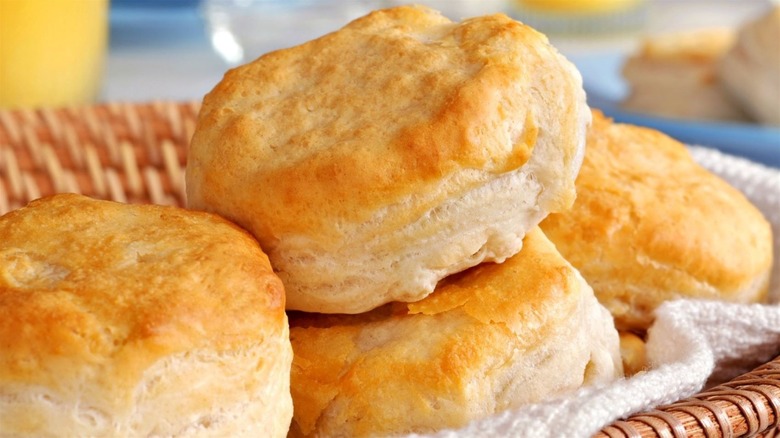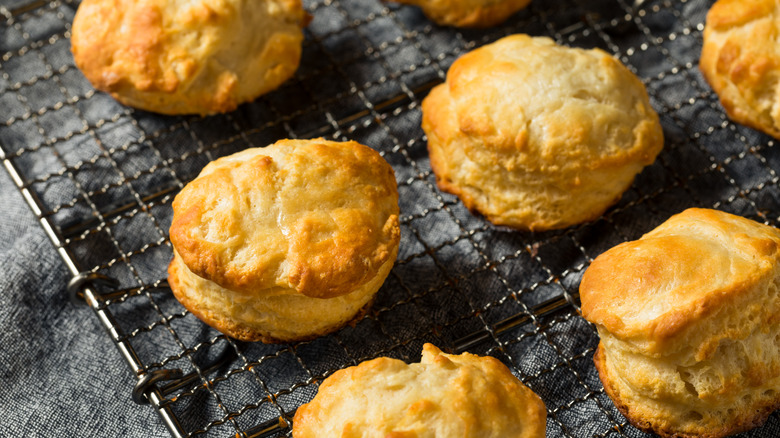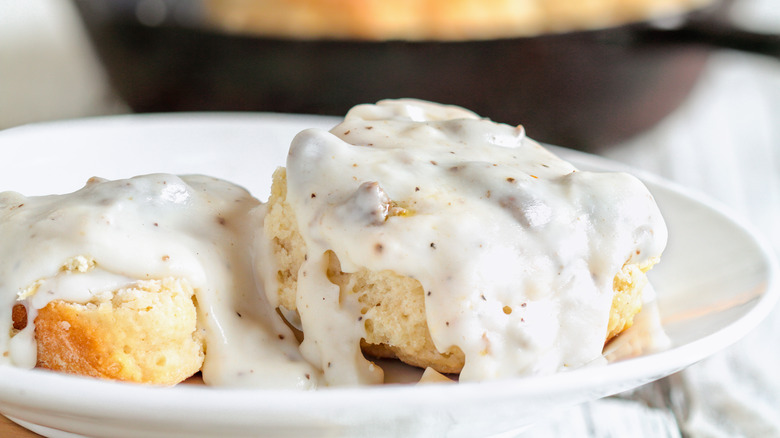The Misleading Instruction You Need To Watch Out For When Making Biscuits
Biscuits may be the quintessential Southern food. Whether slathered with salted butter and jam or doused in sausage gravy, biscuits have a certain status symbol and lore throughout the South and through the world at large. While some swear by a certain recipe or minute tip to ensure the flakiest, most buttery biscuit, there are some surefire, non-negotiables that must be enacted to produce the best biscuits imaginable. No matter if using a simple recipe for buttermilk biscuits or perhaps indulging in something a little more unique, the biscuit-making process has some clear tenets.
Some swear by tricks like grating frozen butter (via Kitchn), stirring the dough precisely 15 times (via Southern Living), or differentiating between rolling with a rolling pin versus folding the dough. Furthermore, though, some recipe instructions can be inadvertently misleading, resulting in crumbly, over-baked, overly firm, or downright disappointing biscuits. Read ahead to learn more about what to avoid when embarking on a homemade biscuit-making journey.
How to bake the perfect biscuits
Allrecipes explains that some common recipe writing nomenclature doesn't extend well to the realm of biscuits. For example, listing a certain number of minutes to bake or even just denoting to bake "until golden brown" can sometimes result in improperly baked biscuits. Allrecipes advocated opting for the lower option, i.e., if a recipe indicates to bake for 12 to 15 minutes, check at the 12-minute mark. Otherwise, your biscuits may dry out. Allrecipes even notes a special trick: Adding cream cheese between your folded biscuit layers, which will impart moistness throughout, ensuring the biscuit isn't dry. Another option would be to brush the tops of the biscuits with butter just before they are done baking, which should give a golden sheen to the tops of the cooked biscuits.
Biscuits too flaky? There might be too much flour in your recipe. Be sure you're properly measuring your flour, ideally using a scoop and level method. Another time you may introduce too much flour or dry ingredients is when rolling out the dough. If you find that it's stuck and haphazardly throw a handful of extra flour on your work surface or to the top of your dough, that may be throwing off the balance of the dough, resulting in an overly dry or crumbly finished product. Instead, add just a touch of flour to your tools themselves, not to the dough, to make sure that the dry-wet ratio stays consistent.
Final takeaways about biscuit baking
Also, as noted by Allrecipes, don't over-knead or over-fold! It's best to try to handle the dough as little as possible so that you don't overwork the gluten, making for a tough biscuit. Lastly, if the biscuit is grainy, ensure your butter is incorporated well. The frozen, grated butter trick is best for this; otherwise, you may wind up with dry, floury spots in one bite and overly moist, buttery bits in another bite. The grated, frozen method ensures the butter is evenly dispersed throughout the dough.
Southern Living gives some other tips, acknowledging the importance of the buttermilk, noting that the "biscuits are best made quickly by hand," and ensuring that you brush the finished biscuits with melted butter for flavor, color, and aesthetics.
Keep these ideas in mind, and we're sure you'll make some amazing biscuits, no matter if you're enjoying them on a leisurely weekend morning or grabbing one quickly before leaving in a frenzied morning rush.


